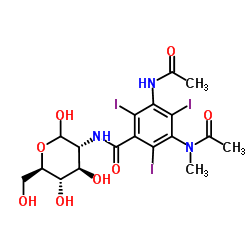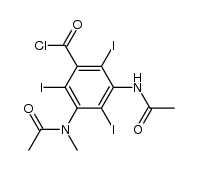31112-62-6
| 中文名 | 甲泛葡胺 |
|---|---|
| 英文名 | Metrizamide |
| 英文别名 |
pyranose
Metrizamide EINECS 250-475-5 2-[({3-(acetylamino)-5-[acetyl(methyl)amino]-2,4,6-triiodophenyl}carbonyl)amino]-2-deoxy-D-glucopyranose Amipaque 2-[3-Acetamido-5-(N-methylacetamido)-2,4,6-triiodobenzamido]-2-deoxy-D-glucose y-d-glucose telebrix300 MFCD00010577 METRIZAMIDE,ULTRAPURE no)-2-deoxy 2-(3-Acetamido-2,4,6-triiodo-5-(N-methylacetamido)benzamido)-2-deoxy-D-glucopyranose 2-({3-(acetylamino)-5-[acetyl(methyl)amino]-2,4,6-triiodobenzoyl}amino)-2-deoxy-D-glucopyranose 2-({3-Acetamido-5-[acetyl(methyl)amino]-2,4,6-triiodobenzoyl}amino)-2-deoxy-D-glucopyranose 2-[3-Acetamido-2,4,6-triiodo-5-(N-methylacetamido)benzamido]-2-deoxy-D-glucopyranose |
| 描述 | Metrizamide(阿米巴)被用作神经放射学检查中血管造影的对比剂[1]。甲酰胺抑制人脑己糖激酶[2]。 |
|---|---|
| 相关类别 | |
| 体外研究 | 甲磺脲是一种具有独特性质的造影剂,其中之一是即使在等渗溶液中,其射线密度也足以进行诊断性脊髓造影[3]。 |
| 参考文献 |
[2]. Bertoni JM. Metrizamide inhibits human brain hexokinase. Neurology. 1982;32(8):884-887. |
| 密度 | 2.3±0.1 g/cm3 |
|---|---|
| 沸点 | 828.5±65.0 °C at 760 mmHg |
| 熔点 | 222-224ºC |
| 分子式 | C18H22I3N3O8 |
| 分子量 | 789.096 |
| 闪点 | 454.8±34.3 °C |
| 精确质量 | 788.854065 |
| PSA | 168.66000 |
| LogP | -0.74 |
| 外观性状 | 白色粉末 |
| 蒸汽压 | 0.0±3.2 mmHg at 25°C |
| 折射率 | 1.761 |
| 储存条件 | −20°C |
Synonym: Section 2 - COMPOSITION, INFORMATION ON INGREDIENTS
Risk Phrases: None Listed. Section 3 - HAZARDS IDENTIFICATION EMERGENCY OVERVIEW
The toxicological properties of this material have not been fully investigated.Light sensitive. Potential Health Effects Eye: Dust may cause mechanical irritation. Skin: No information regarding skin irritation and other potential effects was found. Ingestion: The toxicological properties of this substance have not been fully investigated. Systemic effects may cause meningeal changes in the spinal cord. Inhalation: Inhalation of dust may cause respiratory tract irritation. Chronic: No information found. Section 4 - FIRST AID MEASURES Eyes: Flush eyes with plenty of water for at least 15 minutes, occasionally lifting the upper and lower eyelids. Get medical aid immediately. Skin: Get medical aid. Flush skin with plenty of water for at least 15 minutes while removing contaminated clothing and shoes. Ingestion: If victim is conscious and alert, give 2-4 cupfuls of milk or water. Never give anything by mouth to an unconscious person. Get medical aid immediately. Inhalation: Remove from exposure and move to fresh air immediately. If not breathing, give artificial respiration. If breathing is difficult, give oxygen. Get medical aid. Notes to Physician: Section 5 - FIRE FIGHTING MEASURES General Information: As in any fire, wear a self-contained breathing apparatus in pressure-demand, MSHA/NIOSH (approved or equivalent), and full protective gear. During a fire, irritating and highly toxic gases may be generated by thermal decomposition or combustion. Extinguishing Media: Use water spray, dry chemical, carbon dioxide, or appropriate foam. Section 6 - ACCIDENTAL RELEASE MEASURES General Information: Use proper personal protective equipment as indicated in Section 8. Spills/Leaks: Clean up spills immediately, observing precautions in the Protective Equipment section. Sweep up or absorb material, then place into a suitable clean, dry, closed container for disposal. Avoid generating dusty conditions. Provide ventilation. Section 7 - HANDLING and STORAGE Handling: Wash thoroughly after handling. Remove contaminated clothing and wash before reuse. Use with adequate ventilation. Minimize dust generation and accumulation. Avoid contact with eyes, skin, and clothing. Keep container tightly closed. Avoid ingestion and inhalation. Storage: Keep container closed when not in use. Store in a tightly closed container. Store in a cool, dry, well-ventilated area away from incompatible substances. Section 8 - EXPOSURE CONTROLS, PERSONAL PROTECTION Engineering Controls: Use adequate ventilation to keep airborne concentrations low. Exposure Limits CAS# 31112-62-6: Personal Protective Equipment Eyes: Wear appropriate protective eyeglasses or chemical safety goggles as described by OSHA's eye and face protection regulations in 29 CFR 1910.133 or European Standard EN166. Skin: Wear appropriate protective gloves to prevent skin exposure. Clothing: Wear appropriate protective clothing to prevent skin exposure. Respirators: Follow the OSHA respirator regulations found in 29 CFR 1910.134 or European Standard EN 149. Use a NIOSH/MSHA or European Standard EN 149 approved respirator if exposure limits are exceeded or if irritation or other symptoms are experienced. Section 9 - PHYSICAL AND CHEMICAL PROPERTIES Physical State: Powder Color: white Odor: Not available. pH: Not available. Vapor Pressure: Not available. Viscosity: Not available. Boiling Point: Not available. Freezing/Melting Point: 222.00 - 224.00 deg C Autoignition Temperature: Not available. Flash Point: Not available. Explosion Limits, lower: Not available. Explosion Limits, upper: Not available. Decomposition Temperature: Solubility in water: Specific Gravity/Density: Molecular Formula: C18H22I3N3O8 Molecular Weight: 789.09 Section 10 - STABILITY AND REACTIVITY Chemical Stability: Stable under normal temperatures and pressures. Conditions to Avoid: Incompatible materials, dust generation, strong oxidants. Incompatibilities with Other Materials: Oxidizing agents. Hazardous Decomposition Products: Nitrogen oxides, carbon monoxide, irritating and toxic fumes and gases, carbon dioxide, iodide. Hazardous Polymerization: Has not been reported Section 11 - TOXICOLOGICAL INFORMATION RTECS#: CAS# 31112-62-6: LZ6650000 LD50/LC50: CAS# 31112-62-6: Oral, mouse: LD50 = >20 gm/kg; Oral, rat: LD50 = >20 gm/kg. Carcinogenicity: Metrizamide p.a. - Not listed by ACGIH, IARC, or NTP. Other: See actual entry in RTECS for complete information. Section 12 - ECOLOGICAL INFORMATION Section 13 - DISPOSAL CONSIDERATIONS Dispose of in a manner consistent with federal, state, and local regulations. Section 14 - TRANSPORT INFORMATION IATA Not regulated as a hazardous material. IMO Not regulated as a hazardous material. RID/ADR Not regulated as a hazardous material. Section 15 - REGULATORY INFORMATION European/International Regulations European Labeling in Accordance with EC Directives Hazard Symbols: Not available. Risk Phrases: Safety Phrases: S 24/25 Avoid contact with skin and eyes. S 28A After contact with skin, wash immediately with plenty of water. S 37 Wear suitable gloves. S 45 In case of accident or if you feel unwell, seek medical advice immediately (show the label where possible). WGK (Water Danger/Protection) CAS# 31112-62-6: No information available. Canada None of the chemicals in this product are listed on the DSL/NDSL list. CAS# 31112-62-6 is not listed on Canada's Ingredient Disclosure List. US FEDERAL TSCA CAS# 31112-62-6 is not listed on the TSCA inventory. It is for research and development use only. SECTION 16 - ADDITIONAL INFORMATION N/A |
CHEMICAL IDENTIFICATION
HEALTH HAZARD DATAACUTE TOXICITY DATA
|
| 安全声明 (欧洲) | 22-24/25 |
|---|---|
| RTECS号 | LZ6650000 |
| 包装等级 | I; II; III |
| 危险类别 | 6.1 |
|
~% 
31112-62-6 |
| 文献:US4021481 A1, ; |




